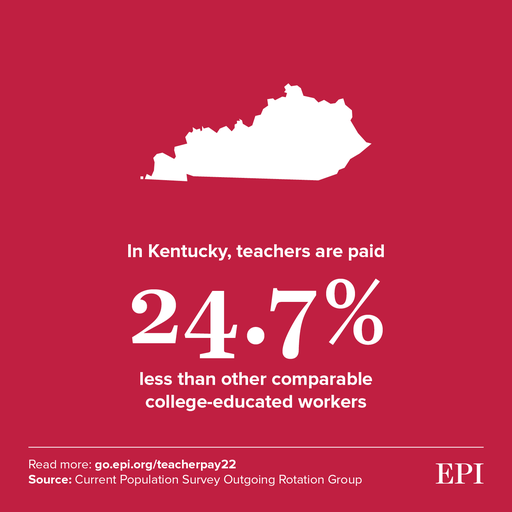
Volume 58, Issue 6
Another Reason for the Teacher Shortage: Pay Gap Getting Worse for Educators Across Entire U.S., Kentucky Ranks 36th
On average, U.S. teachers earned 23.5% less than non-teacher college-educated professionals in 2021 – a record high. Kentucky’s gap is 24.7%.

The report credits the disparity as a key contributor to the national educator shortage, making it increasingly difficult for school districts across the nation to recruit and retain teachers.
In 1996, the pay gap stood at 6.1%. After reaching 22% in 2018, the pay gap narrowed slightly (due to Red for Ed actions in various states) to 19.2% in 2019 before widening in each of the past two years with the most recent data (2021) showing a record-high 23.5% teacher pay penalty.
Each of the 50 states and Washington, D.C. has a pay gap. In many states, teachers will have to see substantial and sustained salary increases, as well as benefit enhancements, to reduce this gap and make teaching a more attractive career choice. Kentucky ranks 36th in the pay gap problem, worst among its neighboring states. That makes it even harder to keep teachers from heading across state lines for better pay.
In more than half of U.S. states, the pay gap is 20% or higher. Colorado has the most significant gap – a 35.9% penalty. Four other states have a pay gap of at least 30%. They are Oklahoma (32.8%), Virginia (32.7%), Arizona (32%), and Alabama (30.6%).
The state with the smallest pay gap is Rhode Island (3.4%). The only other states with a pay gap of less than 10% are Wyoming (4.0%), New Jersey (4.5%), and South Carolina (8.3%).
EPI has been conducting these pay studies for eighteen years, as well as other research on education funding and the teacher shortage. This report includes a dire warning on the impact of low teacher pay and insufficient education funding. It is a warning that every Kentucky public school teacher, administrator and school board member—as well as every elected legislator—knows all too well:
Without targeted and significant policy action—not just on teacher pay but on school funding more generally—there can be no reasonable expectation of reversal in sight for pandemic-stressed schools and those who serve public education (see Allegretto, García, and Weiss 2022). For teachers, the pandemic exposed and heightened long-standing fissures—including worsening shortages of permanent teachers and qualified substitutes. This report again sounds the alarm on the long erosion in relative teacher wages and the widening gap in total compensation—which makes the prospects for attracting and retaining the teachers needed to alleviate shortages difficult at best.
More Articles:
PRO’S CORNER: 2022 Teacher of the Year Lisa Hanson Suggests Canva for Classroom Creativity
IRS Update: Maximum Educator Expense Deduction Rises to $300 in 2022
Deadline for KEA 2022-23 Read Across America Grants is September 15
KEA Announces New Partnership with Campbellsville University
